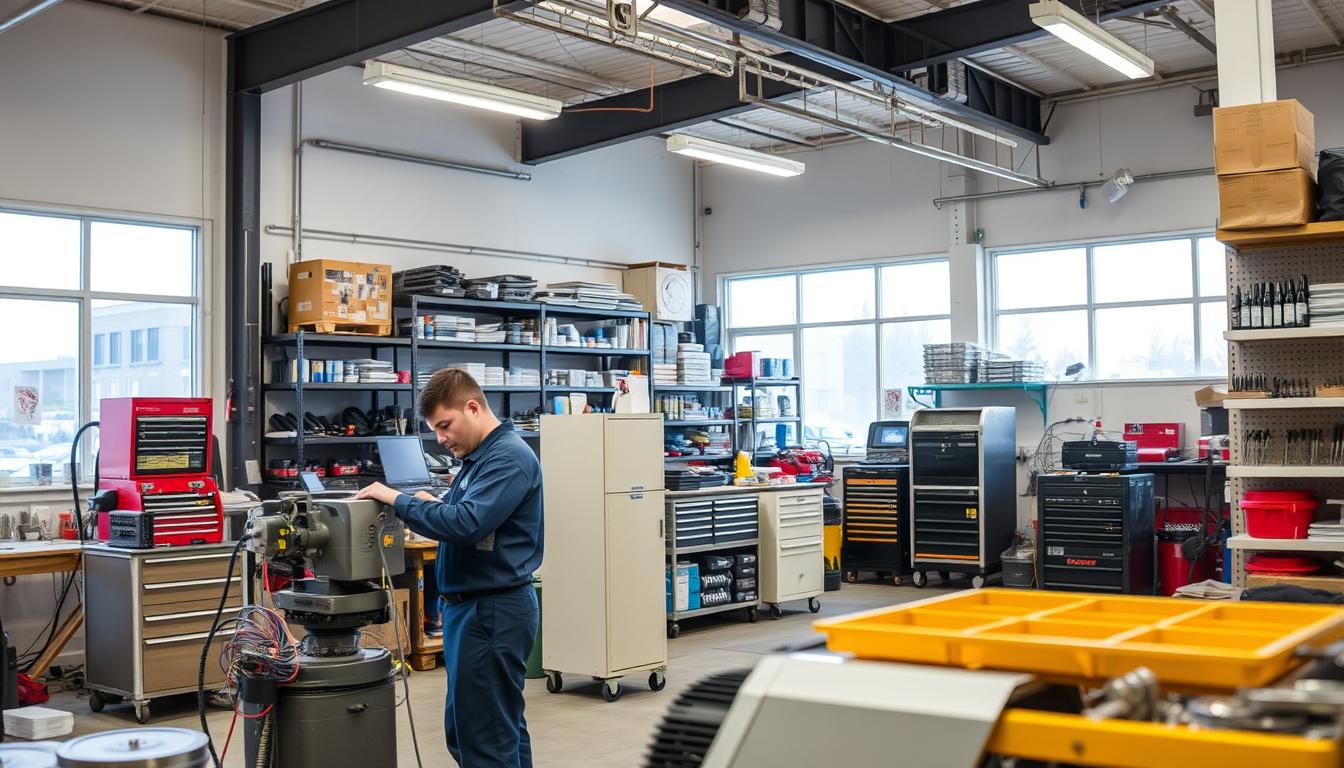
What if a small, scheduled check could stop your biggest equipment failures?
We help businesses across North Vancouver and West Vancouver protect their assets and keep operations running smoothly. Our approach uses preventive maintenance to reduce unexpected downtime and extend the life of your equipment.
Our simple, practical guide outlines inspection checklists, cleaning standards, lubrication intervals and parts replacement windows. We document every action with photos and service logs so you have clear records for insurers, regulators and your team.
By taking a proactive strategy, you avoid costly emergency repairs and support worker safety and customer experience in your buildings and production areas. We tailor each plan to local climate impacts so HVAC and building systems perform reliably through wet winters and warm summers.
Ready to tailor a right-sized program? Call Lord Mechanical LTD at 604-670-3737 for North Vancouver and West Vancouver support.
Key Takeaways
- Scheduled upkeep cuts downtime and boosts asset lifespan.
- Clear documentation creates defensible records for insurers.
- Local climate adjustments keep equipment reliable year-round.
- Right-sized programs scale from small to complex sites.
- Contact Lord Mechanical LTD at 604-670-3737 for tailored service.
Understand today’s intent: why Canadian businesses need a proactive maintenance strategy
Unexpected equipment breakdowns bite into cash flow and customer trust.
Preventive maintenance keeps systems running, lowers unplanned downtime, and extends asset life. It reduces costly emergency repairs and improves safety across sites. Deloitte research shows predictive approaches can raise productivity by 25%, cut breakdowns by 70% and trim maintenance costs by 25%.
We link a clear maintenance strategy to business results: steadier revenue, fewer interruptions, and better energy efficiency. Using data-driven scheduling lets you prioritise work so you avoid premium emergency callouts.
Reducing disruptions and meeting compliance
- Fewer interruptions: less downtime for HVAC, pumps and production lines.
- Safer sites: scheduled checks support provincial regulations and protect people.
- Predictability: time to budget, staff and notify tenants.
| Benefit | Business impact | Example |
|---|---|---|
| Lower emergency costs | Reduced overtime and rush parts | Quarterly HVAC filter and coil work prevents airflow failures |
| Improved reliability | Fewer service interruptions | Pumps serviced to avoid production stoppages |
| Better planning | Steadier cash flow and budgets | Scheduled windows avoid peak-season conflicts |
We help management and operations convert reactive spending into a strategic reliability driver. Call Lord Mechanical LTD at 604-670-3737 to align your needs with practical service levels.
Preventive maintenance explained: what it is and how it differs from predictive and prescriptive approaches
Routine inspections and simple tasks stop minor wear becoming major outages.
Preventive maintenance is scheduled work designed to keep equipment reliable. It covers inspections, cleaning, lubrication, and planned parts replacement so you avoid unexpected failures.
Time-based, usage-based and condition-based
Time-based work runs on a calendar—quarterly filter changes, for example. Usage-based actions trigger after run hours or cycles, such as lubricating after 500 starts.
Condition-based approaches use sensor readings or visual checks. You act when vibration, temperature, or oil signs show deterioration.
Where predictive and prescriptive fit
Predictive maintenance uses software and data to forecast failure windows. It makes sense for high-value or critical assets with reliable telemetry.
Prescriptive systems go further, using AI to recommend exact tasks and parts at the optimal time.
Risk prioritization and deferred work
We prioritise by safety, environmental impact and production consequence. Deferred work raises long-term risk and cost.
- Example: a pump with a vibration sensor flags a bearing replacement, avoiding a full teardown.
We help you blend simple scheduling and analytics so you invest where it returns most. Call Lord Mechanical LTD at 604-670-3737 for tailored support in North and West Vancouver.
When to use preventive maintenance and when not to
Deciding which assets deserve a schedule versus a quick-replace approach starts with understanding failure patterns.
We recommend preventive maintenance for assets with predictable wear and for equipment that is critical to operations. These items justify planned service because scheduled work reduces downtime and replacement costs.
We prioritise hazardous applications—gas lines, boilers and pressurised systems—where routine inspection lowers safety risk and liability. Regular checks here protect people and property.
- Reactive is fine for low-value or random-failure parts like light bulbs or simple fittings. PM for these can raise labour and parts costs without cutting risk.
- Failure mode awareness guides action: wear-out components get scheduled service; random failures need spares and fast response.
- Risk-based focus means inspections target safety, environmental impact and business continuity first.
| Asset class | Best approach | Why |
|---|---|---|
| Critical plant (pumps, chillers) | Scheduled service | Predictable wear, high consequence of failure |
| Hazardous systems (boilers, gas) | Frequent inspections | Safety and regulatory requirements |
| Low-cost items (bulbs, simple valves) | Reactive | Random failures, low repair value |
We help you catalogue each asset’s risk and repairability so PM delivers the strongest return. Call Lord Mechanical LTD at 604-670-3737 for North and West Vancouver support.

How to build a preventive maintenance plan step by step
Start with clear, measurable goals that link every service task to business outcomes like uptime and safety.
We begin by setting specific goals tied to lower downtime, better safety and predictable costs. Next, inventory assets by family and location and link each item to OEM manuals, warranty terms and applicable standards.
Prioritise, define and prepare
Perform a risk review to rank assets by criticality and consequence of failure. Write concise work orders that list steps, labour time, materials, lockout requirements and acceptance checks.
Train your team on safe procedures and troubleshooting. Stage spare parts, consumables and special tools so technicians finish tasks in one visit.
Measure and improve
Define KPIs and a feedback loop to track results and refine intervals. Align the program with your operating calendar to avoid peak conflicts.
| Step | Owner | Key metric |
|---|---|---|
| Set goals | Operations management | Downtime reduction (%) |
| Asset inventory & OEM mapping | Asset team | Asset coverage (%) |
| Work orders & training | Lead technicians | First-time fix rate (%) |
| Resources & review | Procurement | Parts availability (%) |
We can help you craft a practical preventive maintenance program and an example schedule to start quickly. Call Lord Mechanical LTD at 604-670-3737 for North and West Vancouver support.
From plan to calendar: creating a maintenance schedule that avoids production disruption
Turn your asset list into a practical calendar that keeps operations moving.
Assess labour productivity and clear the backlog
We start with a simple assessment of time and output. Technicians typically spend 25–35% of hours on hands-on work. With better staging and clear work orders that can reach 50%.
We analyse the backlog, then assign people, hours, materials and tools to each task. This reduces repeat visits and cuts unexpected downtime.
Schedule tasks by window, condition and production needs
Group work by location and trade to lower travel and setup time. Sequence jobs by condition indicators, OEM intervals and your operational priorities.
Build flexibility while protecting the 80/20 balance
Reserve capacity for reactive events but aim to keep at least 80% of hours as scheduled maintenance. This balance protects uptime and improves overall performance.
Use detailed work orders to streamline execution
Work orders must include lockout/tagout steps, materials lists and photos so crews arrive ready. We stage parts, pull permits and notify stakeholders before the window.
“Scheduling with complete information turns planned service into predictable results.”
| Action | Target | Benefit |
|---|---|---|
| Productivity assessment | 25–50% tech hands-on time | More value-added hours, fewer repeats |
| Grouped scheduling | By location & trade | Lower travel time, faster turnaround |
| Protected capacity | 80% scheduled | Reduced downtime, predictable budgets |
If you want help converting a plan into a practical maintenance schedule, call Lord Mechanical LTD at 604-670-3737 for North and West Vancouver support.
Key metrics to track performance and reliability over time
Clear measures make it obvious when your programme is working — and when it needs attention.
We build a concise scorecard for your preventive maintenance program. The first target is PM compliance ≥ 90%. Hitting this keeps reliability high and cuts unplanned downtime.

Core targets and rules
- Scheduled-critical coverage: aim for a critical percentage as close to 100% so urgent items are not missed.
- 80/20 split: keep at least 80% of hours scheduled and under 20% reactive to protect uptime.
- 10% margin rule: finish work orders 10% early to create buffer for unexpected issues.
Measure, trend and report
We use simple dashboards that show data month over month. Key indicators include mean time between failures and repeat work after service.
| Metric | Target | Business impact |
|---|---|---|
| PM compliance | ≥90% | Lower downtime |
| Scheduled-critical | ~100% | Critical tasks done on time |
| Scheduled hours | ≥80% | Fewer emergency callouts |
We align reviews with leadership meetings so resources follow the scorecard. Call Lord Mechanical LTD at 604-670-3737 to set measurable goals and track real results.
Tools and technology: CMMS/EAM software, sensors, and analytics
Modern software connects field checks, sensors and schedules into one clear workflow.
We recommend a CMMS/EAM to centralise assets, standardise tasks and automate scheduling. The system stores service history and live data so you can track KPIs and compliance across sites.
Automating work orders, scheduling, and data capture
Automation creates mobile work orders, lets techs attach photos, and updates the service log in real time. This reduces admin and raises first-time fix rates.
Condition monitoring with sensors for early failure detection
We fit sensors for vibration, temperature and pressure on critical equipment. Early alerts let us target interventions before small faults grow.
Leveraging predictive analytics to cut breakdowns and costs
Predictive maintenance uses historical data and algorithms to forecast failure windows. We apply it selectively to high-value equipment where ROI is clear.
- Templates & mobile workflows keep field crews efficient.
- Alerts & dashboards surface gaps in management and efficiency.
- Asset criticality tags ensure the right work is prioritised.
| Tool | Value | Use case |
|---|---|---|
| CMMS/EAM | Centralised records, auto-scheduling | Standardise a preventive maintenance program across sites |
| Sensors | Early fault detection | Vibration on pumps, temp on motors |
| Analytics | Failure forecasting | Apply predictive maintenance for critical assets |
“Right-sized technology makes service predictable and cost-effective.”
Call Lord Mechanical LTD at 604-670-3737 to align tools to your budget and start a reliable preventive maintenance program in North and West Vancouver.
Preventative maintenance plans tailored for North Vancouver businesses
Tailoring service to real usage cuts costs while protecting critical assets and operations.
Local context: HVAC, production equipment, and building systems
We focus on the systems that feel North Vancouver weather first: HVAC, hydronic loops, backflow devices and building pumps. Quarterly HVAC filter and coil work, semi-annual pump checks and annual valve exercising reduce failures during wet winters and warm summers.
Aligning strategy with climate, usage patterns, and budgets
We right-size scope so high-run equipment gets more attention while backup assets have longer intervals. This lowers unnecessary costs and keeps production schedules intact.
Schedule expert support from Lord Mechanical LTD at 604-670-3737
We document every visit for insurance, warranties and municipal checks. We coordinate with your team to minimise tenant disruption and match service windows to your operations and production peaks.
| Asset | Typical action | Frequency / Benefit |
|---|---|---|
| HVAC systems | Filter & coil clean | Quarterly / improved airflow, lower energy |
| Building pumps | Seal checks & calibration | Semi‑annual / avoid outages |
| Backflow & valves | Leak detection & exercising | Annual / compliance and safety |
| Production equipment | Usage-based inspections | As-run / reduced downtime |
Example: a mixed-use package might include quarterly HVAC cleaning, semi-annual pump inspections and yearly leak detection. Call Lord Mechanical LTD at 604-670-3737 for a preventive maintenance program built to your needs in North and West Vancouver.
Conclusion
A focused reliability strategy turns routine checks into measurable business value.
A disciplined preventive maintenance program is the clearest way to protect equipment and assets while cutting downtime and failure risk. Define goals, standardise inspection steps, stage parts and resources, and lock work orders to a realistic schedule.
Success depends on people: your team and ours following clear work orders, sharing feedback, and adjusting the plan with steady management discipline. Use lightweight software to coordinate orders, capture data and prove results over time.
Ready to prioritise an assessment and protect your equipment? Call Lord Mechanical LTD at 604-670-3737 for North Vancouver and West Vancouver support.

